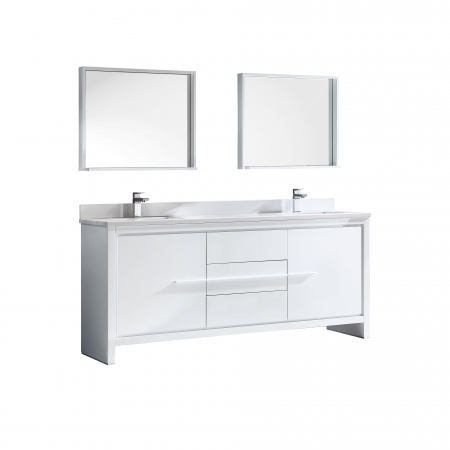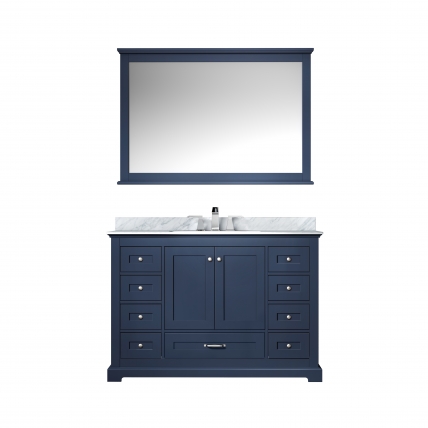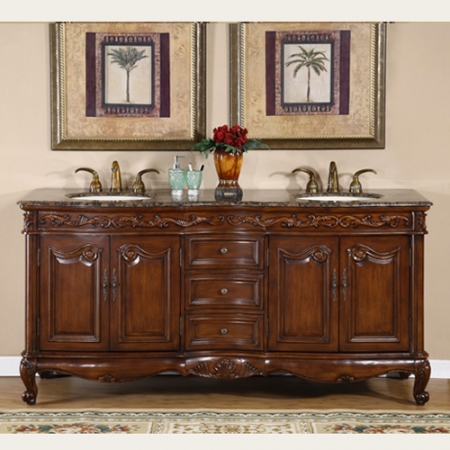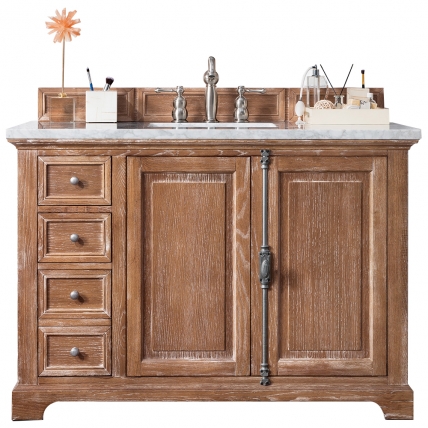- Vanities
- Shop By Size
- Shop By Type
- Single Sink Vanities
- Double Sink Vanities
- Vanities Without Tops
- Console Sinks
- Narrow Depth Vanities
- Small Double Vanities
- Farmhouse Vanities
- Vessel Sink Vanities
- Floating Vanities
- Offset Sink Vanities
- Modern Vanities
- Rustic Vanities
- James Martin Vanities
- L&K Vanities
- Silkroad Exclusive Vanities
- Lexora Home Vanities
- Shop By Finish
- Shop All Vanities
- ON SALE
- Clearance Pick Up Only
- Linen Cabinets
- Sinks
- Plumbing
- Mirrors
- Lighting
- Accessories
- Buying Guides
Bathroom Remodel Tips for Bathroom Vanity Material Types
When you are in the process of choosing a new vanity for your bathroom, there are a lot of things to consider. However, one of the most important is "what material is the best to use for a vanity in a bathroom remodel?" Whether you’re updating a few items in the space or doing a complete remodel, you need to consider what is best for the bathroom, yourself, and your wallet.
Anyone who renovates wants the work to last. So choosing a vanity that is durable and capable of handling moisture and humidity is essential. But if you don’t know a lot about the different vanity materials, it might seem as if any choice is as good as the next one. This article will provide insight into the pros and cons of vanity materials.
Related: Tips to Care for Your Bathroom Vanity
What Are The Most Common Types of Wood Bathroom Vanities?
The most common types of vanities for bathrooms will be made of plywood, rubberwood, medium-density fiberboard (MDF), or solid hardwood. Unfortunately, deciding which to use isn’t as easy as one being far better than the others. As with many decisions, it comes down to your needs. How you use the bathroom and your personal style will both factor into your final decision.
We’ll share what to expect from each of these materials when used for bathroom vanities. In addition, we’ll share the pros and cons of each so you get a better idea of how these vanities will function in your home. Once you finish reading, you’ll likely know which material you want for your new bathroom vanity.
Related: How to Protect Wood Bath Vanities from Moisture
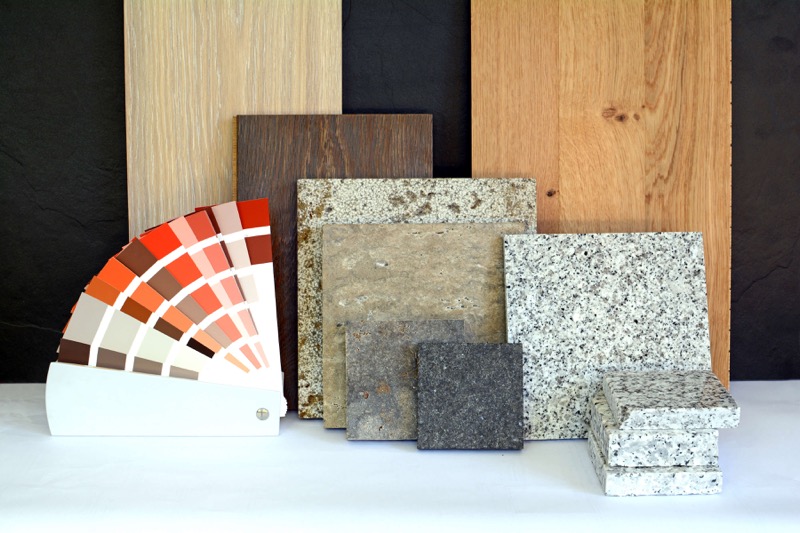
Plywood Bathroom Vanities
Plywood isn’t as high-end as some other materials used for vanities. However, it can be reliable and sturdy for the bathroom. This is a material made up of several wood veneers that are glued together in layers to create a sheet. Similar to other manufactured woods, plywood quality varies based on the quality of the materials and the thickness of the plywood.
Lower-quality plywood is going to use softer woods that don’t stand up well. On the other hand, it could have gaps in between the layers. When choosing plywood, it’s essential to be sure it’s solid or durable, or it will not last. Quality plywood will be water-resistant, which makes it a good choice for any bathroom.
72 Inch White Modern Double Sink Bathroom Vanity
Rubberwood Bathroom Vanities
Another material that is common in bathroom vanities is rubberwood. This kind of wood is created from the rubber tree. It’s extremely strong and has the same durability as wood from an oak tree. In addition, rubberwood is an eco-friendly option for those who want to create a green bathroom. It also has a unique aesthetic that many people appreciate in modern spaces.
However, there are a few drawbacks to using rubberwood. For one, it’s perishable and may decay more quickly than other materials. It can also trigger latex allergies, so it should not be used in spaces with someone who has that allergy. During the drying process, this kind of wood can also warp. However, seasoning can alleviate that concern.
Related: 11 Steps to Remodeling Your Bathroom
48 Inch Single Sink Bathroom Vanity in Navy Blue with Choice of No Top
Medium Density Fiberboard (MDF) Bathroom Vanities
Medium-density fiberboard is the third option for bathroom vanities. It also happens to be one of the most inexpensive choices for those on a strict budget. MDF is engineered using wood chips and fibers. These are compressed together and bound together using resin or wax adhesives. As a result, it tends to be more durable than plywood.
MDF isn’t a perfect material, however. It isn’t going to stand up to as much wear and tear as solid hardwood. In addition, it’s required that the MDF be sealed, especially for use in the bathroom. When this material isn’t properly sealed, it will start to swell and fall apart when exposed to moisture.
72 Inch Double Sink Bathroom Vanity with Counter Choice
Solid Hardwood Bathroom Vanities
When you want the premium option, solid hardwood is the best choice. However, it’s essential to be aware that hardwood comes in two varieties. One is solid wood, which is made entirely of natural wood, and the other is solid hardwood, which may include several different types of hardwood. Hardwood has an excellent look that is hard to match with other materials.
When it comes to the disadvantages of solid hardwood, keep in mind that this wood may not always do well in areas with constant temperature changes. It can also absorb water and expand in extreme heat. This can make it hard to use in a bathroom unless you are sure it’s quality hardwood made for the kind of environment.
Related: How to Create a Bathroom Remodel Budget
48 Inch Single Sink Bathroom Vanity in Driftwood Finish
How to Choose the Best Vanity Material for Your Bathroom?
So how do you know which kind of wood is right for your bathroom vanity? There are several things to take into account. The list below will give you a starting point to go off of as you make a choice that matches your budget:
Moisture Resistance – If your bathroom is often covered in water or you aren’t managing humidity in the space, you should choose a vanity material that resists moisture. If you want to go the extra mile, make sure it’s waterproof, so it’s sure to last for years into the future.
Durability – How is your vanity typically used? If you have kids or pets that sit near the sink, you want to be sure the surface is smooth, strong, and durable. Also, when wear and tear are expected, you want to be sure you go with the vanity that will last the longest. This ensures there’s no need to replace it in years to come.
Budget – The amount you have available to spend is also a crucial factor when choosing a bathroom vanity. This can be the final determining factor about whether you go with solid hardwood, MDF, plywood, or something else.
When choosing a vanity, make sure you select materials that will last in your specific bathroom. Think about budget, aesthetics, and strength to ensure you get a vanity that works for you. Take the information above and use it to decide which materials are appealing to you. You’ll be sure to choose a vanity that you enjoy seeing every time you enter the bathroom.
Related: The Pros and Cons of Common Bathroom Vanity Materials
48 Inch Single Sink Bathroom Vanity in Mango Wood

